Discover Gorgonzola Cheese: A Creamy Italian Delight
I love cheese, and Italian cheeses are my favorite. Gorgonzola is a standout. It’s a blue-veined cheese that has won the hearts of food lovers everywhere. It shows Italy’s amazing food culture.
Gorgonzola is a mild blue cheese with a unique mold. It comes from the town of Gorgonzola in northern Italy. This cheese has a long history, adding to Italy’s rich food traditions.
Table of Contents
The Historic Origins of Gorgonzola Cheese
Gorgonzola, one of the oldest blue-veined cheeses, has its roots in the 9th century. It comes from the regions of Piedmont and Lombardy in northern Italy. This cheese’s history is tied to the area’s rich culinary and agricultural traditions.
Tracing the Roots of Gorgonzola to Medieval Lombardy
Shepherds in Lombardy noticed something special about their cheeses. They were stored in caves and had turned green-blue with a unique flavor. At first, they thought it was a mistake. But soon, this unique look and taste became what made the cheese special.
The Accidental Discovery of Blue-Veined Cheese
The discovery of blue-veined cheese was a happy accident. Local cheesemakers, through their curiosity and creativity, created something amazing. This cheese, once seen as a flaw, is now a beloved Italian treasure.
Gorgonzola, a famous Italian blue cheese from Piedmont and Lombardy, has been produced since the 9th century and holds PDO status since 1996.
Gorgonzola’s Journey to Culinary Fame
The making of Gorgonzola cheese started in the 15th century. But its roots go back even further. Artisans in Lombardy worked hard to make the best cheese. They chose the best molds and aged it perfectly.
The village of Gorgonzola, near Milan, became famous for this cheese. It was a key place for making and trading Gorgonzola. This cheese quickly became loved by the nobility and merchants in Milan.
Its unique taste and creamy texture won many hearts. By 1955, Gorgonzola was officially recognized as a true Italian cheese. It got the Protected Designation of Origin (DOP) status.
Now, Gorgonzola is loved all over the world. It’s a key ingredient in many dishes. Its journey from a local cheese to a global favorite shows its lasting appeal.
| Cheese | Characteristics |
|---|---|
| Gorgonzola | Bold, blue-veined cheese with a creamy texture |
| Feta | Salty cheese with a whisper of the Aegean sea breeze |
| Parmesan | Sharp as wit, grating into the dust of ancient lands |
“Gorgonzola’s journey to culinary fame is a testament to the dedication of generations of cheesemakers and the enduring appeal of its distinctive flavor.”
The Art of Gorgonzola Cheesemaking
Gorgonzola, the iconic blue cheese from Italy, shows the rich heritage and art of cheesemaking. It’s made from whole cow’s milk, either raw or pasteurized. The process creates its green-blue veins and complex flavors.
Traditional Production Techniques
The making of Gorgonzola starts with adding special bacterial cultures and molds. Penicillium roqueforti is key for its blue-green veining. After curdling, the cheese is salted and aged in natural caves for weeks to months.
During aging, the cheese is pierced with iron needles. This spreads the mold and flavors evenly. It makes the cheese creamy and intense, with sweet notes as it ages.
Gorgonzola’s Distinctive Characteristics
The result is a Gorgonzola with a natural rind and unique look. It has green or blue veins in its creamy interior. The taste is complex, with a mix of savory and sweet that delights the taste buds.
| Gorgonzola Variety | Texture | Flavor Profile | Aging Period |
|---|---|---|---|
| Gorgonzola Dolce | Softer, creamier | Milder, sweeter | 2-3 months |
| Gorgonzola Piccante | Firmer, crumblier | Sharper, more pungent | 3-6 months |
The art of gorgonzola cheese production and blue cheese making in Italy has been perfected over centuries. It’s what makes Gorgonzola a beloved Italian cheese around the world.
Sartori Dolcina Gorgonzola Cheese in the Kitchen
Gorgonzola, a famous Italian blue cheese, brings depth and complexity to many dishes. It’s great on its own or with fresh fruit. Its unique flavors work well in both traditional and modern recipes.
Classic Pairings and Recipes
Gorgonzola and Pear is a classic favorite. The cheese’s creamy, tangy taste pairs well with sweet pears. This mix creates a delightful contrast of flavors.
Gorgonzola is also perfect for sauces and creams in pasta, risottos, and with meats. It adds a rich, indulgent flavor.
In gourmet dishes, like Gorgonzola Risotto, the cheese blends well with rice. This creates a memorable taste experience. Gorgonzola cheese recipes often use it in sauces, dips, and dressings, showing its kitchen versatility.
| Recipe | Ingredients | Nutrition (per serving) |
|---|---|---|
| Creamy Gorgonzola Dressing |
|
|
The creamy Gorgonzola Dressing is great with salads, veggies, breads, and chicken wings. It’s a tasty blue cheese pairing option. You can also use blue cheese, feta, or goat cheese for a different taste.
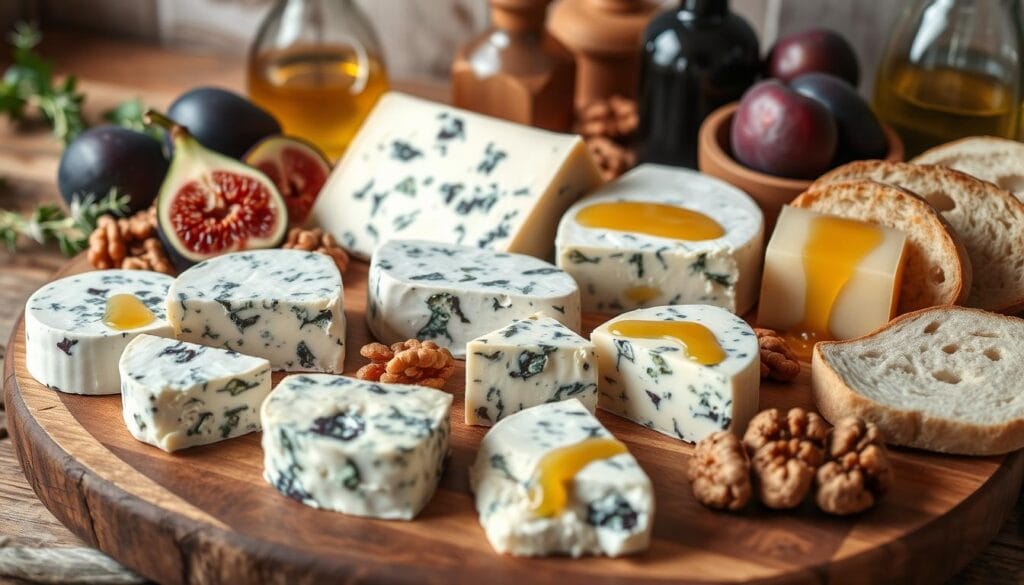
Gorgonzola’s bold flavors make it a star in Italian cheese cuisine. It’s perfect for both classic and modern dishes. From rich risottos to fresh salad dressings, this cheese makes any dish special. It invites you to try new things in the kitchen.
Gorgonzola Cheese: A Versatile Ingredient
Gorgonzola, the iconic Italian blue cheese, is a true gem in the culinary world. It offers a unique blend of flavors and textures. This creamy delight has gained a well-deserved reputation for its exceptional quality and versatility.
Gorgonzola’s journey as a culinary staple began in the 15th century. In 1955, it received the prestigious Protected Designation of Origin (DOP) status. This solidified its place as a true Italian artisanal treasure. The cheese is made from whole cow’s milk, either raw or pasteurized. It undergoes a maturation process in natural caves that can last from a few weeks to several months.
One of the distinctive features of Gorgonzola is the way it is crafted. The cheese is regularly pierced with iron needles during the maturation process. This encourages the spread of the blue-green Penicillium mold. The result is a creamy, compact texture with a complex taste.
Gorgonzola’s Versatility in the Kitchen
Gorgonzola’s versatility is truly remarkable. It is a beloved ingredient in a wide range of culinary applications. From classic pairings like Gorgonzola and pear to its use in sauces, creams, and gourmet dishes like Gorgonzola risotto, this Italian cheese shines in both savory and sweet preparations.
Whether crumbled on salads and pizzas, melted into sauces, or enjoyed on its own with bread and wine, Gorgonzola’s rich, tangy flavor profile complements a variety of ingredients and culinary styles. Its versatility is a testament to the skill and artistry of the cheesemakers who have perfected the craft over centuries. This allows Gorgonzola to become a beloved part of Italian culinary heritage.
| Gorgonzola Cheese Varieties | Flavor Profile |
|---|---|
| Gorgonzola Dolce | Milder and creamier |
| Gorgonzola Piccante | Stronger and more intense |
Gorgonzola’s versatility extends beyond its culinary applications. It is also known for its nutritional benefits. As a rich source of calcium, vital for bone health, and a good source of protein, Gorgonzola can be a valuable addition to a balanced diet. Additionally, the cheese contains beneficial bacteria believed to contribute to a healthy gut microbiome.
Whether you’re a seasoned gourmet or a home cook seeking to expand your culinary horizons, Gorgonzola cheese offers endless possibilities for creative and delicious discoveries. Its unique flavor, artisanal heritage, and versatility make it a true gem in the world of Italian gastronomy.
The Unique Flavors of Gorgonzola Cheese
Gorgonzola, the iconic Italian blue cheese, captivates the senses with its distinct flavor profile. It has a creamy texture and a natural rind. The cheese is adorned with elegant green or blue veins, depending on the variety.
The taste of Gorgonzola is extraordinary. It has an intense, complex, and slightly spicy essence. Sweet notes develop during the maturation process.
Gorgonzola cheese is mainly produced in the northern Italian regions of Piedmont and Lombardy. The unique climatic conditions and traditional cheesemaking techniques contribute to its exceptional character. The cheese’s distinctive flavors come from the Penicillium roqueforti mold used in its production.
This mold imparts a captivating blend of tanginess, funkiness, and creaminess.
The two main types of Gorgonzola, Gorgonzola dolce and Gorgonzola piccante, offer vastly different taste experiences. The younger Gorgonzola dolce has a gentle, mellow flavor. The more mature Gorgonzola piccante has a more robust and rustic taste due to its longer aging period.
“Gorgonzola cheese is one of the most versatile and flavorful blue cheeses, offering a unique taste experience that is cherished by cheese enthusiasts around the world.”
Whether you’re enjoying Gorgonzola in a classic Italian dish, crumbling it over a salad, or savoring it on its own, the cheese’s captivating flavor profile is sure to leave a lasting impression. Discover the depth and complexity of this iconic Italian cheese and explore the myriad ways it can elevate your culinary creations.
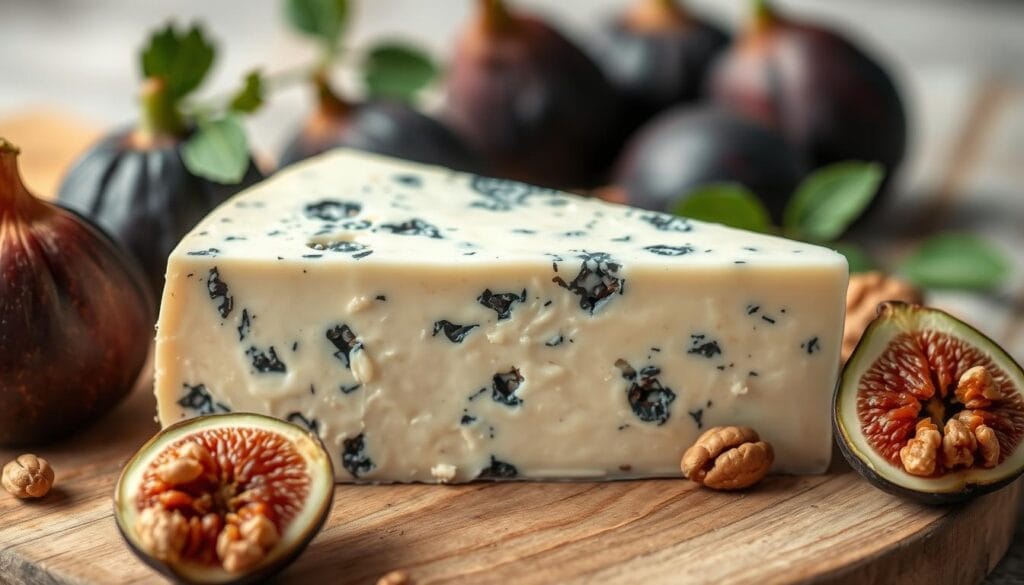
Embracing the Creamy Delights of Gorgonzola Cheese
Gorgonzola, the iconic Italian blue cheese, is a true delight for the senses. Its rich, creamy texture and distinctive tangy-yet-subtle flavor make it a beloved ingredient in the world of gourmet cuisine. Embracing the unique pleasures of Gorgonzola cheese is a journey worth exploring, as it opens up a world of culinary possibilities and gastronomic enjoyment.
One of the key attributes that sets Gorgonzola apart is its storied history. Originating in the Lombard region of Italy, this renowned cheese has been crafted with care and precision for centuries, evolving into a true symbol of Italian culinary excellence. Its official Protected Designation of Origin (DOP) status, granted in 1955, underscores the authenticity and quality that have made Gorgonzola a cherished part of the Italian gastronomic heritage.
Beyond its rich history, Gorgonzola’s versatility in the kitchen is truly impressive. Whether incorporated into creamy sauces, sprinkled atop salads, or melted into decadent dishes, this blue cheese adds a unique depth of flavor that elevates any meal. Its ability to seamlessly complement a wide range of ingredients, from pears and walnuts to beef and pasta, makes Gorgonzola a valuable ally in the quest for gorgonzola cheese enjoyment and blue cheese appreciation.
Embracing the creamy delights of Gorgonzola cheese is not just a culinary experience, but a celebration of the italian cheese experience. With its artisanal production methods and distinct flavor profile, Gorgonzola invites food enthusiasts to indulge in the rich tapestry of Italian gastronomy and uncover the true essence of this remarkable dairy treasure.
“Gorgonzola is not just a cheese, but a piece of Italian history and culture, waiting to be savored and appreciated by those who seek the finest culinary pleasures.”
Whether you’re a seasoned connoisseur or a newcomer to the world of Gorgonzola, the opportunity to explore and savor this exceptional cheese is one that should not be missed. By embracing its creamy delights, you’ll embark on a gastronomic journey that celebrates the very heart of Italian culinary artistry.
Nutritional Benefits of Gorgonzola Cheese
Gorgonzola, the iconic Italian blue cheese, is packed with nutritional benefits. It’s not just about its rich, creamy taste. It’s also a great source of essential nutrients for a healthy diet.
Gorgonzola is high in protein, with 21 grams in every 100 grams. This makes it a great choice for anyone looking to boost their protein intake. Protein is key for muscle health, tissue repair, and overall well-being.
It’s also a calcium powerhouse, with 357 milligrams per 100 grams. That’s 36% of your daily calcium needs. Calcium is crucial for strong bones and preventing osteoporosis.
| Nutrient | Amount per 100g | % Daily Value |
|---|---|---|
| Calories | 356 kcal | – |
| Total Fat | 29 g | 37.18% |
| Protein | 21 g | 42% |
| Carbohydrates | 3 g | – |
| Sugars | 1 g | – |
| Sodium | 1146 mg | 49.83% |
| Calcium | 357 mg | 36% |
Gorgonzola cheese contains probiotics, which are good for your gut. These probiotics can help with inflammation and digestion.
Gorgonzola also has vitamins A and B vitamins. Adding it to your diet can boost your nutrient intake in a tasty way.
Gorgonzola’s rich, creamy texture and distinctive blue-veined appearance make it a beloved ingredient in many Italian and international cuisines.
Enjoy Gorgonzola in salads, pasta, or as a snack. It’s a nutritious choice for a balanced diet. Its health benefits and delicious taste make it a favorite for cheese lovers and health enthusiasts.
Conclusion: Savor the Legacy of Gorgonzola Cheese
Gorgonzola, the iconic Italian blue cheese, is a true treasure of Italy’s food heritage. Its rich history goes back to the 9th century. This creamy delight from Lombardy has won hearts around the world.
From its accidental discovery to the artisanal ways it’s made, Gorgonzola’s story shows Italy’s love for cheese. It’s a symbol of Italian cheesemaking’s passion and skill.
Exploring Gorgonzola’s uses in cooking reveals its versatility and richness. Its creamy texture and blue veins make it a standout in Italian cheeses.
Enjoying Gorgonzola, whether alone or in a dish, is a way to celebrate its legacy. It’s a journey that honors the gorgonzola cheese legacy, the blue cheese appreciation, and the italian cheese heritage it embodies.
FAQ
What is Gorgonzola cheese?
Gorgonzola is a blue cheese with a rich Italian history. It’s known for its unique flavor and creamy texture. This cheese comes from Lombardy and is loved by food lovers around the world.
How did Gorgonzola cheese originate?
Gorgonzola’s story begins in medieval Lombardy. Shepherds found a blue-veined cheese by accident. They made cheese in caves near Gorgonzola village, where it developed a special flavor.
When did the production of Gorgonzola cheese officially begin?
Official Gorgonzola production started in the 15th century. Before that, the blue-veined cheese existed. Artisans then perfected the making process, choosing the best molds and aging techniques.
What is the production process of Gorgonzola cheese?
Gorgonzola is made from whole cow’s milk, raw or pasteurized. Bacterial cultures and molds are added. The cheese is then salted and aged in caves for weeks to months.
During aging, iron needles are used to spread the mold. This ensures the flavor is evenly distributed.
What are the characteristics of Gorgonzola cheese?
Gorgonzola has a natural rind and a creamy texture. It’s dotted with green or blue veins. The taste is intense, complex, and slightly spicy, with sweet notes.
How is Gorgonzola cheese used in cooking?
Gorgonzola is versatile and adds depth to many dishes. It’s great on its own or with fruit. It’s also used in traditional Italian recipes and as a base for sauces and creams.
What are the nutritional benefits of Gorgonzola cheese?
Gorgonzola is nutritious and offers health benefits. It’s rich in protein, calcium, and vitamins and minerals. The blue mold may also have antioxidant and anti-inflammatory properties.

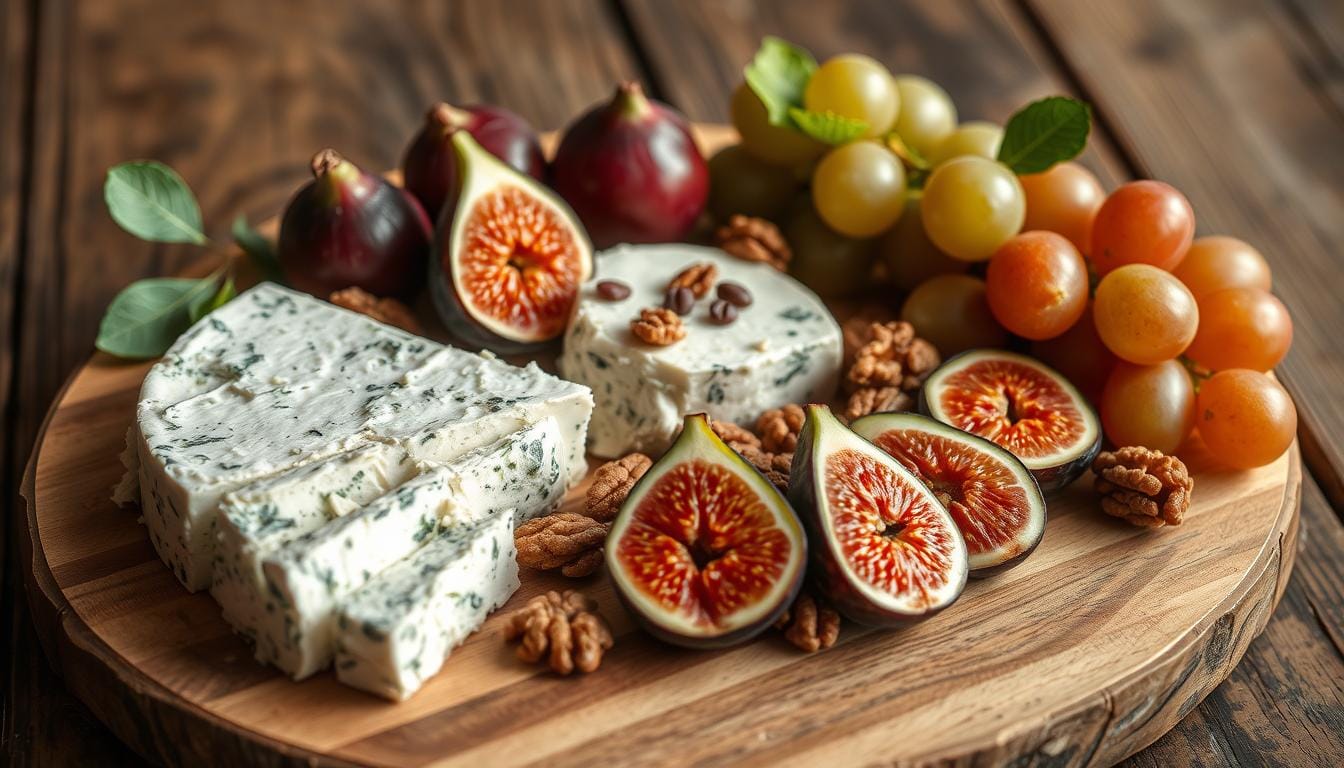
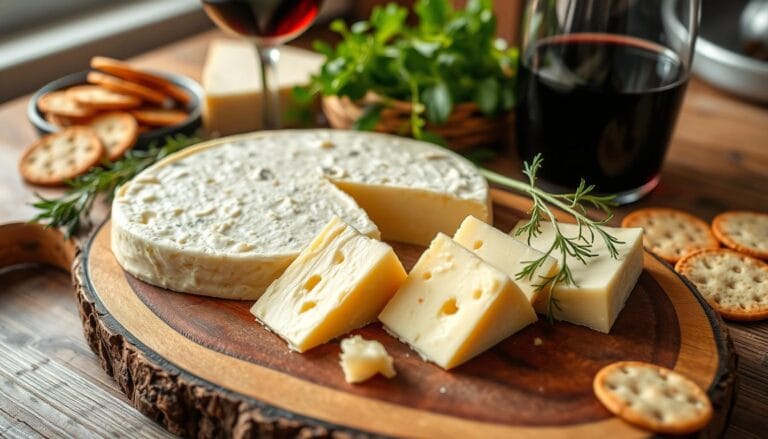



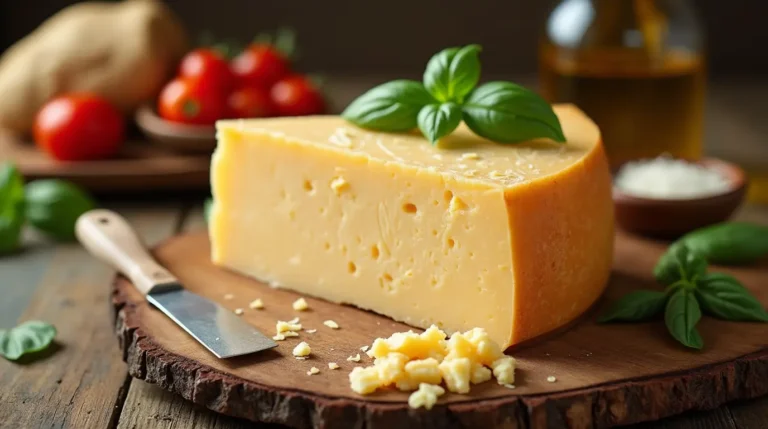
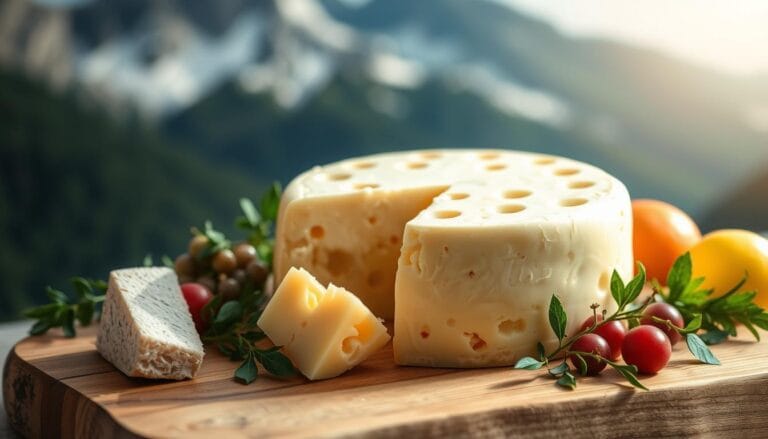
3 Comments
Comments are closed.